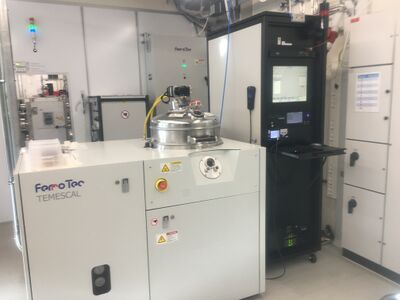Specific Process Knowledge/Thin film deposition/10-pocket e-beam evaporator
Feedback to this page: click here
This page is written by DTU Nanolab staff
This page is under construction
E-Beam Evaporator (10-pockets)

The 10-pocket electron-beam evaporator allows line-of-sight deposition of 10 different materials. Line-of-sight deposition means that only the surface of the sample facing the source directly is coated, which is useful for example for lift-off. This particular machine was purchased by Nanolab in 2023. It was made by Temescal, a company owned by FerroTec, and is very similar to the other Temescal e-beam evaporator bought by Nanolab in 2018, which we call E-beam Evaporator (Temescal).
In both Temescal e-beam evaporators, wafers are loaded into the top of the chamber, called the product chamber. This product chamber acts as a loadlock because it can be separated from the rest of the chamber by a large gate valve. Deposition will happen on all samples that are loaded together. You can load up to four 6" wafers or three 8" wafers for deposition on surfaces facing the evaporation source, or on up to one 6" wafer for tilted deposition. Using sample holder inserts, you can deposit on samples of different sizes and shapes. One material can be deposited at a time, and you can deposit many layers one after another.
Some special features of the 10-pocket system compared to the other Temescal e-beam evaporator are:
- sample heating up to 250 °C
- it is possible to add a low oxygen flow
- we have silicon, silica and alumina available for deposition in this machine.
You need specific training to use these special options.
Note that you should only deposit oxides and silicon right in the afternoon of a day before a scheduled service as they can cause a lot of flakes in the machine.
The user manual, user APV, and contact information can be found in LabManager:
E Beam Evaporator (10-pockets) in LabManager
Training videos may be found here:
Process information
- Acceptance Test. Describes thickness uniformity tests, side wall deposition tests, sheet resistance tests and tests of the ion source for substrate cleaning.
Materials for e-beam evaporation
These materials are available in the 10-pocket e-beam evaporator:
- Aluminium (Al)
- Aluminium oxide (Al2O3)
- Chromium (Cr)
- Copper (Cu)
- Germanium (Ge)
- Gold (Au)
- Nickel (Ni)
- Platinum (Pt)
- Silicon (Si) - the 10-pocket evaporator still needs to be added to this page
- Silicon oxide (SiO2) - the 10-pocket evaporator still needs to be added to this page
- Silver (Ag)
- Titanium (Ti)
Most of these materials are fixed and will always be present in the machine: Al, Cr, Au, Ni, Pt, Si, Ag, and Ti. A few of them are deposited from liners and may be exchanged on request: Al2O3, Cu, Ge, and SiO2. If you wish to evaporate a material that is not on this list, you should use the E-beam Evaporator (Temescal), where you can request almost any metal. For other materials you may be able to use sputtering or ALD - see the list of available materials on the Overview page.
Thickness measurement, deposition rate and process control
Read about how the machine measures the thickness of the growing film using a quartz crystal monitor, how accurately you can control the rate/thickness, and other useful information about e-beam deposition here: Thickness, rate, process control.
Particulates in the films
Read about optimizing film quality including how to minimize the number of particulates in Au films in the E-beam evaporator (Temescal).
| Purpose | Deposition of metals |
|
|---|---|---|
| Performance | Film thickness |
|
| Deposition rate |
| |
| Thickness uniformity |
| |
| Thickness accuracy |
| |
| Process parameter range | Process Temperature |
Higher for refractive metals that require a lot of heat to evaporate, see above. |
| Process pressure |
| |
| Source-substrate distance |
| |
| Substrates | Batch size |
|
| Substrate material allowed |
| |
| Material allowed on the substrate |
|
* For thicknesses above x nm please request permission so we can ensure that enough material will be present.
** Defined as the ratio of the standard deviation to the average of the measurement made using the DektakXT. For further details see the acceptance test.

